The Thought Fox Analysis
“The Thought Fox” is a famous poem taken from his volume, The Hawk in the Rain. Hughes uses poetic masks like that of the fox and particularly of the wolf. The fox here, is a symbol of the contradictory nature of things. The scope of this symbol gradually extends from personal to universal significance.
Like several other poems, it deals with the conflict between two selves. The poem commences with an exposition of the protagonist’s imagined picture. The poet imagines what the conditions will be in the forest, in a moment at midnight. He is in his room expecting inspiration, with the clock ticking away. He feels that there is something else besides this loneliness of midnight and the quiet movement of his fingers on the blank sheet of paper.
As he looks out of his window there is not even a star to illuminate the environment. He senses the entry of something into his loneliness. In the cold night, a fox’s nose, delicate as the snow, seems to touch a tender twig, a leaf.
Strangely enough, even the white snow is not visible in the dark night. The poet notices the two eyes of the fox. Wherever the gaze of the fox moves, the poet recognizes prints in the snow. The poet becomes aware of the movement of two eyes that seem to make clear prints on the snow repeatedly between the trees. He recognizes a shadow lagging behind.
As the poem develops this figment of the imagination develops from airy nothing to receive a habitation and a name. The imagined self becomes a reality for the speaker and works out into the uttered word, the poem. The second self appears after quite some time, startling the reader out of his complacency. The imaginary ‘I’ meets another ‘I’ peeping into his privacy,
“Till, with a sudden sharp hot stink of fox
It enters the dark hole of the head.”
One wonders whether it is really another self or the poet’s presentation of the first ‘l’ as a third person. The obsessive notion of the staring eye comes up:
“an eye,
A widening deepening greenness…
Coming about its own business …”
The poem ends with a return to worldly reality but, as Thomas West observes, we “…discover now a printed page which reveals” an external world of time and long dead imaginings (in print), which feels very distant from the imaginative act, this dark and secret reality of the mind’s possession by something akin, in its apartness and its and its energy, to the jaguar.
The Thought Fox Line by Line Analysis
- I imagine…alive- The poet is busy composing the poem at midnight. He imagines that moment in a forest. Midnight moment’s forest-the appearance of the forest at that moment.
- Something else is alive— he feels that some other creature is also awake at that moment.
- Clock’s loneliness– the only sound heard is the ticking of the clock. The poet personifies the clock and says that it was all alone.
- Blank page where my fingers move- his fingers move on the blank sheet of paper as he writes his poem.
- Window…no star- He looks out of the window. It is pitch dark and there is not even a single star to illuminate the world.
6-8. Something more near…loneliness- He is unable to see any star but he senses the presence of something else. He feels that it is not just a fleeting airy local presence but one which has a form going far deeper into the darkness.
9-10. Cold, delicate…leaf– Suddenly he feels a fall in the temperature. The cold touch is very delicate, like a fox smelling a twig, a leaf.
11-13. Two eyes serve…snow– The poet recognizes the two staring eyes, the source of his inspiration. Hughes often speaks of staring eyes. Here he refers to the eyes of a fox but in several later poems, inspiration reaches him through the two staring eyes of a wolf. He is able to see very clearly the repeated movement of the eyes of the fox. They set neat prints everywhere on the ‘snow.
Also Read:

Hello, Viewers! Besides being the Founder and Owner of this website, I am a Government Officer. As a hardcore literary lover, I am pursuing my dream by writing notes and articles related to Literature. Drop me a line anytime, whether it’s about any queries or demands or just to share your well-being. I’d love to hear from you. Thanks for stopping by!
